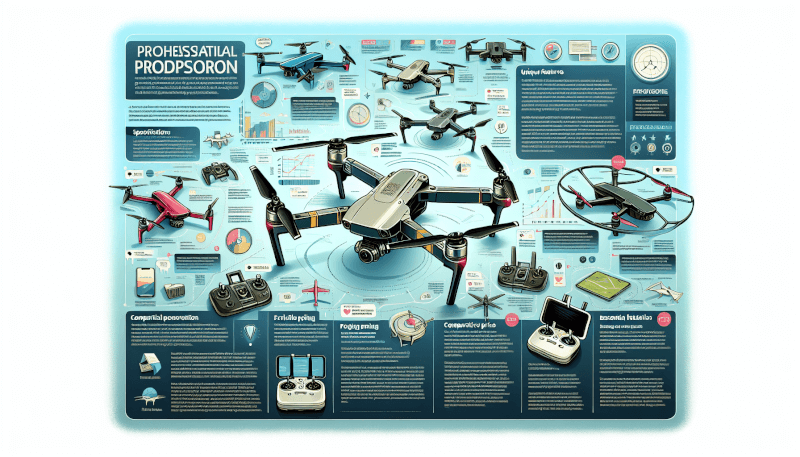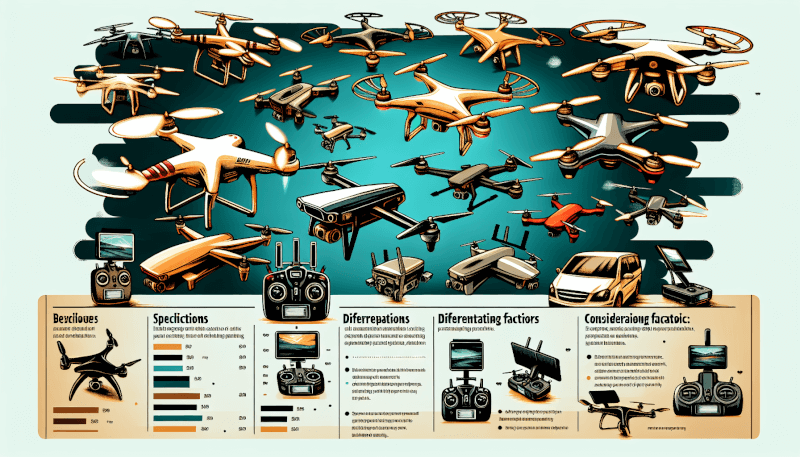Looking to take your drone photography to the next level? In this article, you will find a comprehensive buyer’s guide to help you make an informed purchase when it comes to professional-grade drones. From understanding the different features and specifications to considering your specific needs and budget, this guide will equip you with all the necessary knowledge to choose the perfect drone for capturing stunning aerial footage. So, get ready to soar to new heights and elevate your photography game with a professional-grade drone!
Factors to Consider
When it comes to purchasing a professional-grade drone, there are several factors that you should consider. These factors will ultimately determine the quality and functionality of the drone, as well as how well it fits your specific needs and preferences. From flight time and battery life to camera quality and intelligent flight modes, each aspect plays a crucial role in your overall drone experience. Let’s take a closer look at each factor and explore what you should keep in mind before making your purchase.
Flight Time and Battery Life
Flight time and battery life are essential factors to consider when choosing a professional-grade drone. The longer the flight time, the more time you can spend capturing breathtaking aerial footage or engaging in other drone activities. A drone with a shorter flight time may limit your opportunities to explore and enjoy the vast possibilities that drones offer.
Battery life is closely linked to flight time, as it determines how long your drone can stay in the air before needing a recharge. It’s important to consider both the flight time and the charging time of the drone’s battery. In some cases, it may be beneficial to invest in extra batteries to extend your flight time and reduce downtime waiting for a recharge.
When comparing different drones, be aware that flight time can vary significantly depending on the drone’s weight, motor efficiency, and flying conditions. It’s always a good idea to read reviews or consult with experts to get a realistic idea of a specific drone’s flight time and battery life.

Camera Quality
One of the main reasons people invest in professional-grade drones is for their exceptional camera capabilities. Whether you’re a professional photographer or simply want to capture stunning aerial shots, camera quality should be a top priority. When evaluating the camera quality of a drone, consider factors such as resolution, image quality, and the ability to capture smooth and stable footage.
Resolution and image quality determine how detailed and crisp your photos and videos will be. Look for drones that offer high resolutions, such as 4K or even higher. This will ensure that your footage is sharp and can be used for professional purposes or enjoyed in vivid detail.
Another crucial feature to consider is stabilization and gimbal technology. A stabilized camera provides smooth footage even when the drone is moving or encountering turbulence. A gimbal helps to keep the camera level, minimizing shakiness and producing professional-level footage.
Finally, consider the availability of lens options for the drone’s camera. Having the ability to interchange lenses allows you to adapt to different shooting scenarios and capture a wide variety of shots.
Range and Transmission Quality
For a truly immersive and enjoyable drone experience, it’s important to have a drone that offers a sufficient control range and reliable transmission quality. The control range refers to the maximum distance at which you can control the drone, while transmission quality relates to the strength and clarity of the live video feed from the drone’s camera.
When evaluating the control range, consider the distance you intend to fly your drone and whether the drone can meet your specific needs. Keep in mind that there may be legal restrictions on the maximum control range in your area, so familiarize yourself with local regulations before purchasing a drone with an extensive control range.
The transmission technology also plays a vital role in ensuring a smooth and uninterrupted connection between the drone and your remote controller. Look for drones that use advanced transmission technologies, such as OcuSync or Lightbridge, as they provide reliable and stable connections. Additionally, consider the quality of the live video feed and whether it offers real-time streaming in high definition.
Interference and signal strength are also factors to consider when evaluating the range and transmission quality of a drone. Look for drones that utilize multiple-frequency bands to minimize interference and provide a strong signal even in crowded areas.

Flight Control System
The flight control system is another critical factor to consider when purchasing a professional-grade drone. The flight control system encompasses the remote controller features, autonomous flight modes, GPS and positioning systems, and obstacle avoidance technology.
The remote controller is your primary interface for controlling the drone. Ensure that it is user-friendly and offers intuitive controls. Look for features such as customizable buttons or knobs that allow you to fine-tune the drone’s flight behavior or camera settings.
Autonomous flight modes are a useful addition to any professional-grade drone. These modes enable the drone to perform certain pre-programmed actions, such as following a subject or flying along a predetermined route. Consider the different autonomous flight modes available and choose a drone that offers the ones that align with your needs and creative vision.
GPS and positioning systems play a crucial role in ensuring precise and accurate flight. They enable the drone to maintain its position and altitude, even in challenging conditions. Additionally, GPS allows for features like return-to-home, which brings the drone back to its takeoff point with the push of a button.
Obstacle avoidance and sensor technology are essential for safe and stress-free flying. Look for drones that incorporate obstacle sensors to detect and avoid obstacles in their flight path. This feature is particularly useful when flying in unfamiliar or crowded areas.
Intelligent Flight Modes
Intelligent flight modes add a new level of creativity and convenience to your drone flights. These modes enable the drone to perform specific actions without requiring constant manual control. Let’s explore some of the popular intelligent flight modes you should consider when choosing a professional-grade drone.
Follow Me mode allows the drone to autonomously track and follow a subject, keeping it in the frame at all times. This mode is perfect for capturing dynamic action shots or filming yourself engaging in outdoor activities.
Waypoints and route planning mode allows you to pre-program a specific flight path for your drone. This is useful when you want the drone to follow a predetermined route for filming a particular location or creating stunning aerial timelapses.
Active Track or subject tracking mode enables the drone to track and follow a moving subject. By selecting the subject on the live video feed, the drone will automatically adjust its flight path to keep the subject in focus.
Gesture control mode allows you to control the drone’s flight and camera using hand gestures. This mode is especially useful when you want to capture a quick selfie or execute a specific flight maneuver without relying on the remote controller.
Orbit or circle mode enables the drone to fly in a circular pattern around a point of interest. This mode is ideal for capturing panoramic shots or creating compelling cinematic footage.
By considering which intelligent flight modes are essential to your drone activities, you can select a professional-grade drone that offers the right combination of features to enhance your creativity and streamline your flights.

Portability and Size
Portability and size are crucial aspects to consider, especially if you plan on taking your drone on outdoor adventures or traveling frequently. A compact and foldable design allows for easy transportation and storage, making it simpler to carry your drone wherever you go.
Consider the weight of the drone as well. A lighter drone is generally easier to transport and maneuver. Keep in mind that some areas may have restrictions on the maximum weight of drones that can be flown legally.
Additionally, consider whether the drone comes with a carry case or bag for added convenience and protection during transportation. A well-designed carry case not only protects your drone but also provides storage space for accessories like extra batteries, propellers, and cables.
Build Quality and Durability
When investing in a professional-grade drone, it’s important to choose one that is built to withstand the challenges of outdoor flying. The build quality and durability of a drone determine its ability to withstand impact, harsh weather conditions, and other external factors.
Look for drones that are made from high-quality materials, such as carbon fiber or durable plastics. These materials offer excellent strength-to-weight ratios, ensuring that your drone can withstand accidents and survive rough landings.
Water and dust resistance are also crucial features to consider, especially if you plan on flying your drone near bodies of water or in dusty environments. Some drones come with an IP rating that indicates their level of resistance to water and solid particles.
Furthermore, consider whether the drone has crash protection features such as propeller guards or a robust frame design. These additions can help protect the drone’s critical components during accidental collisions or crashes.

Cost
Cost is an important factor to consider when purchasing a professional-grade drone. While it’s tempting to opt for the most expensive option, it’s crucial to find a balance between your budget and the features you need.
Before making a purchase, determine your budget and prioritize the features that are most important to you. Think about the value for money, considering not only the initial cost of the drone but also any potential additional costs, such as accessories or extra batteries.
It’s also essential to consider the long-term investment of owning a professional-grade drone. Will the drone meet your needs in the future, or will you outgrow its capabilities? Consider your evolving skills and requirements to ensure that the drone you choose will continue to serve you well over time.
Customer Reviews and Reputation
When evaluating a professional-grade drone, it’s essential to consider the experiences and opinions of other users. Reading customer reviews provides valuable insights into the performance, reliability, and overall satisfaction of a specific drone.
Look for reliable sources of information, such as reputable online retailers, professional drone websites, or forums dedicated to drone enthusiasts. Pay attention to both positive and negative reviews to get a balanced perspective on the drone’s strengths and weaknesses.
Additionally, consider the reputation of the manufacturer. Brands that have been in the industry for a long time and have a track record of producing high-quality drones are generally more reliable. Look for brands with a solid reputation for customer satisfaction, innovation, and continuous support.

Manufacturer Support and Warranty
Last but not least, consider the manufacturer support and warranty provided with the drone. A reputable manufacturer will offer comprehensive customer support and assistance if you encounter any issues or have questions about the drone’s operation.
Look for manufacturers that provide detailed user manuals, online resources, and responsive customer support channels. It’s reassuring to know that you can rely on the manufacturer for prompt and helpful assistance.
Warranty coverage is also an important aspect to consider. A solid warranty protects your investment and provides peace of mind. Look for drones that come with a reasonable warranty period and clear terms of coverage. Additionally, consider the manufacturer’s policies regarding product returns and repairs to ensure a smooth process in case you need to make use of the warranty.
By carefully considering each of these factors – flight time and battery life, camera quality, range and transmission quality, flight control system, intelligent flight modes, portability and size, build quality and durability, cost, customer reviews and reputation, and manufacturer support and warranty – you can make an informed decision and find the perfect professional-grade drone that meets your specific needs and elevates your aerial experiences. Happy flying!


